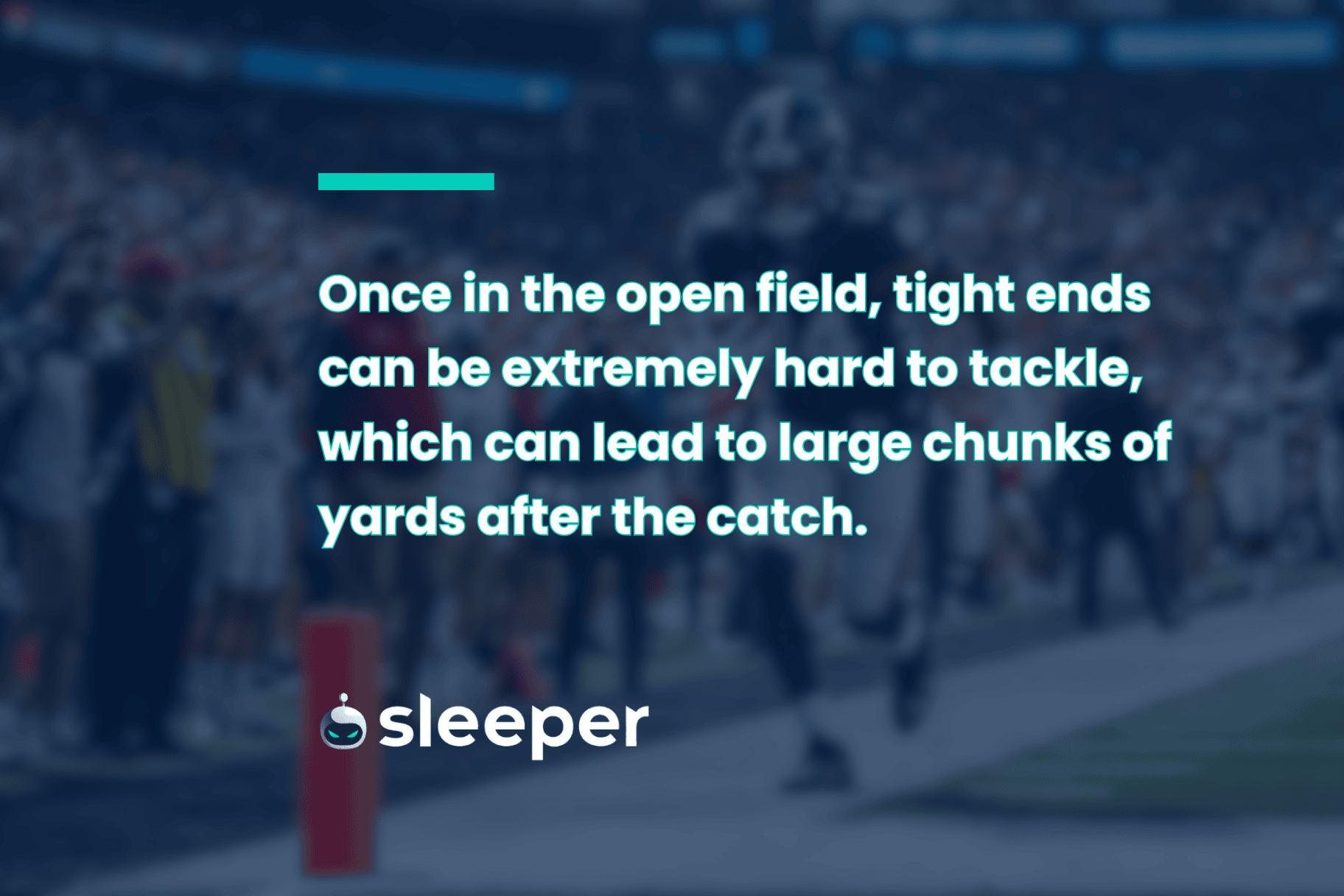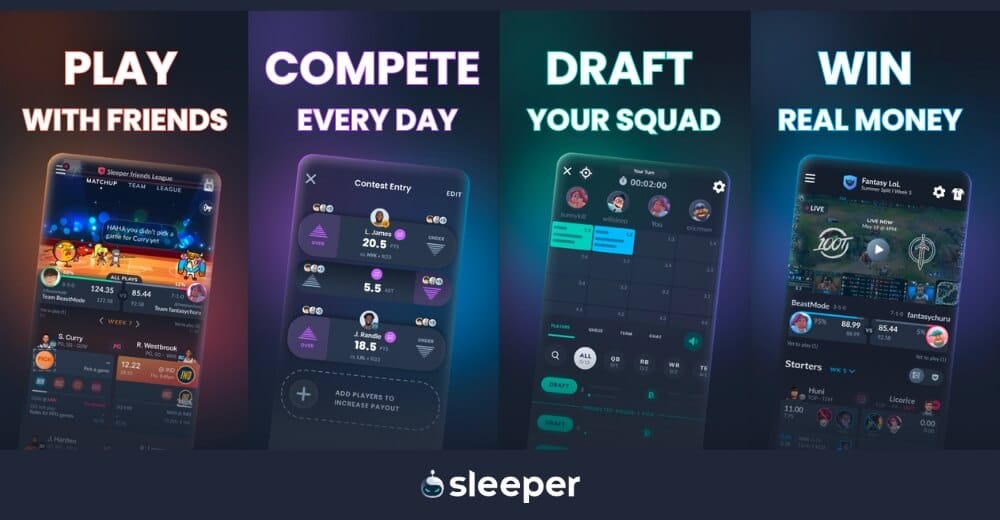Tight ends have become increasingly important in modern football, with the best ones offering elite blocking and pass-catching ability as a way to completely alter a team’s strategy and outlook.

Each position in the NFL comes with its own set of tasks and level of importance. As it relates to tight ends, the tasks can be two-fold, and if your team happens to have one of the studs at the position in the league at a given time, it’s a massive game-changer for your outlook. Read on to learn more about the position, the best ones in the game (and all-time) and what it takes to become a member of the elite.
What Is a Tight End in the NFL?
A tight end is one of the more versatile and indispensable players on a team’s roster, given that it’s effectively a combination of an offensive lineman and a receiver. Tight ends are generally bigger than wide receivers but smaller than the behemoth linemen who they help support, and that combination of size and athleticism makes for a unique weapon as coordinators and coaches strategize offensive gameplans.
What Does a Tight End Do?
A tight end’s primary responsibilities are blocking, running routes and catching passes. He’ll line up on either side of the line to help block, or perhaps block and then break free up on a short route as a safety valve receiver for a quarterback whose top options may be covered.
At his most prolific, a tight end will run fully formed routes and be a reliable set of hands for a medium-depth pass. Due to their combination of size and speed, once in the open field tight ends can be extremely hard to tackle, which can lead to large chunks of yards after the catch. They’re also often called upon as receivers in the red zone, where their size is a major asset against defenders in short-yardage situations.
Why Is It Called a Tight End?
Tight ends usually line up alongside the tackles on the offensive line, creating a tighter end to the line and greater protection for the quarterback. The positioning has since gotten a bit more liberal, with some TEs lining up in the slot or even wider.

The Best Tight Ends of All Time
The GOAT TE debate slants heavily toward the modern game, with more athletic players emerging at the position and with more TEs stacking up outrageous statistical seasons and even becoming focal points for their offenses:
Rob Gronkowski (New England Patriots, 2010-18; Tampa Bay Buccaneers, 2020-21)
Gronk was a staple during the back half of New England’s two-decade run of greatness, linking up with Tom Brady to devastating effect. The two reunited in Tampa Bay for one last go-around, and all Gronk did was score two touchdowns in another Super Bowl triumph for the duo. Brady and Gronk combined for 105 touchdowns in the regular season and playoffs.
Travis Kelce (Kansas City Chiefs, 2013-present)
The Chiefs’ dynasty does not happen without Kelce, whose consistency, explosiveness and reliability in the clutch have allowed Patrick Mahomes to flourish. Kelce’s worldwide renown may be more attached to his relationship with Taylor Swift, but in NFL circles, he has climbed into the GOAT conversation on his own merit.
Tony Gonzalez (Kansas City Chiefs, 1997-2008; Atlanta Falcons, 2009-2013)
Before Kelce, it was Gonzalez starring in Kansas City. A six-time first-team All-Pro, Gonzalez finished his career in Atlanta in 2013, and he still holds the record for most receptions (1,325) and receiving yards (15,127) by a tight end.
Antonio Gates (San Diego Chargers, 2003-2018)
Gates was an absolute phenom at his apex, redefining the position with his athleticism and ability to use his frame to dominate. What’s even more impressive is that he played basketball in college, not football. But after helping lead Kent State to an improbable Elite Eight appearance in 2002, he worked out for the Chargers, and the rest is history. His 116 touchdowns are the most by any tight end in history.
John Mackey (Baltimore Colts 1963-71; San Diego Chargers, 1972)
Lest we forget about the forefathers of the position, Mackey was a beast during his time with the Colts in the 1960s, one of the beneficiaries of Johnny Unitas’s golden arm. There’s a reason the award for best tight end in college football is called the Mackey Award.
Tight Ends in Fantasy Football
Tight ends are vital players in both on-field football and fantasy football. In the fantasy realm, there can be a bit of volatility at the position. Some years, there’s a clear-cut top tier that goes rather early in fantasy drafts, while in others, it’s a bit more of an inconsistent, muddled mess. But considering the positional scarcity, if you’re able to have a reliable difference maker at TE, it can give you a significant edge in your fantasy league.
With tight ends not always netting the same kind of target volume that other receivers get, it can make predicting weekly outcomes a bit of a fool’s errand, but finding those who are efficient and prolific in the red zone is a proven method for success.
If you don’t have one of the top options, then streaming tight ends — scouring the waiver wire on a regular basis to rotate players into the position — is another way to go. Assessing matchups and seeing where the opportunities are to rack up the catches and yards is what you’ll have to do if that’s your approach.
Since tight-end productivity can be so volatile, some leagues offer a “tight end premium” format, which awards tight ends 1.5 points per catch — 0.5 more than the typical 1 for PPR — and adds another wrinkle to league settings. TE premium customization is available in Sleeper leagues.
See also: Positions in Football

Frequently Asked Questions
What’s the difference between a wide receiver and a tight end?
The lines have been blurred in recent years, but tight ends are generally bigger-bodied players who are tasked with much more blocking duties than receivers in addition to catching passes. Receivers regularly run routes and are still counted on to do some blocking, especially downfield when they aren’t the focal point of a play, but their role is way more pass-catch oriented.
What makes a good tight end?
The best tight ends are the do-it-all kinds. They’re matchup nightmares for opposing defensive backs and linebackers due to their size and athleticism, but they also add heft and aptitude to the offensive line and hold their blocks for running backs or other receivers to break through. It’s rare to find reliable tight ends who handle both at a high level, and often tight ends will boast one of those two characteristics.
Who are the best up-and-coming tight ends?
While Kelce is still going strong, there’s a promising generation coming through the ranks. The Las Vegas Raiders’ Brock Bowers, Arizona Cardinals’ Trey McBride, Detroit Lions’ Sam LaPorta and Buffalo Bills’ Dalton Kincaid should be the names to watch through the rest of the 2020s.
Tighten Up Your Fantasy Football Experience With Sleeper
Now that you know more about the tight end position, put that knowledge to good use by playing season-long fantasy football and daily fantasy sports with Sleeper. You can sign up on the website or by downloading the app to get started and enjoy all of the unique features that only Sleeper offers.
You can practice where you’re going to be drafting your tight ends through Sleeper’s robust mock draft setup and then put that experience to use in free and customizable season-long leagues.
If DFS is more your pace, you can play Sleeper Picks and maximize your winnings up to 100x by deciding whether you think players will exceed or fall short of their projected stats.




